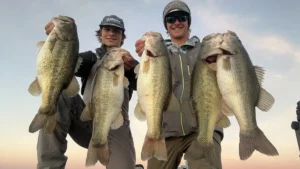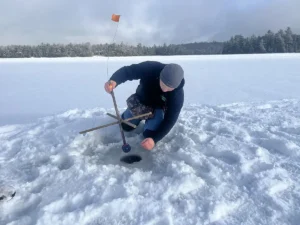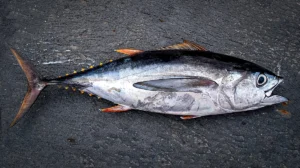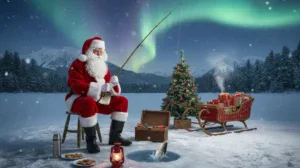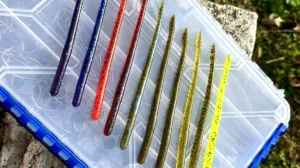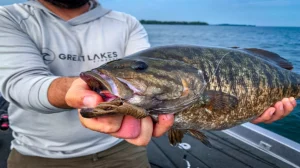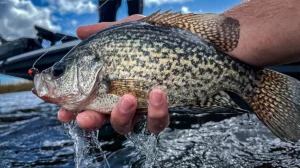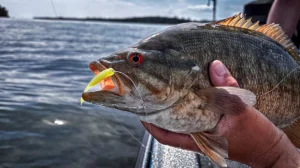“The quality that we call beauty … must always grow from the realities of life.”
Jun’ichirō Tanizaki, In Praise of Shadows
I am a student of all things. The things I am passionate about, I study with greater intent in an attempt to master them. Fishing sits atop those many things. I’ve poured myself into learning and educating folks on fishing, but I also love to study culture and philosophy—specifically Japanese culture. I have studied it since my teenage years. I studied it in college. Some of my favorite books are written by Japanese authors or about Japanese ways of life. In Praise of Shadows, Kokoro, Black Rain, Silence, Zen in Archery and The Book of 5 Rings are a few of my all-time favorite books.
Because of this, Japan has been one of those rare places where many of my passions collide atop my own personal bucket list of places to travel.
For a person who loves culture, cuisine, a sense of purpose in all things, craftsmanship, history and self sacrifice in the name of service, there are few places I would put above Japan. I had longed to travel there for the better part of 4 decades. And now we were finally there.
HONORED FISHING GUESTS IN JAPAN
I, along with Ryan DeChaine from Wired2fish, were privileged to be invited as a guest of Gamakatsu USA and Gamakatsu Japan on a trip to the Gamakatsu Headquarters and to the Osaka Tackle Show in early February. We actually began traveling on my birthday in January and ended the trip after a 44-hour jaunt full of delays, missed flights, layovers, redirections and a case of COVID to boot. And still, I would do it all again even knowing that’s what I had to endure to go on that trip.
I was honored to be invited by Gamakatsu and our friends at SPRO. While I know the trip was for their own business meetings and working with their partners at Big Rock Sports, they treated us as equally honored guests the entire trip. I am still floored by the level of passion my Japanese friends show for serving their company and more importantly others. It is a trait I admire deeply in others, because I have only ever wanted to help other people.
While they treated us like it was their great honor to host us, I feel the honor was more ours. We were honored to meet them, to learn firsthand about their culture, cuisine, business philosophies, fishing, community aspects, and rich, vibrant history from such a storied brand like Gamakatsu and our gracious hosts.

TOURING WITH A LEGENDARY FISHING BRAND
I have long been a Gamakatsu hook user, for decades in fact. Going back to my early years of fishing in the early 90s when they first came stateside, and I have continued to use them thanks to the many advances they’ve had in recent decades with sharpness, durability, coatings for ease of penetration and application specific techniques.
The brand has a rich history, born in the home of the current President of Gamakatsu, Mr. Toshitaka Fujii. His father, Shigekatsu Fujii, was a fisherman who wanted to make a better fishing hook focused on nature and technology. In 1955, when he started, he was bending the wire by hand at a small table with his wife in their kitchen and packaging them for sale. He then traveled 12 hours to Tokyo to sell the hooks at tackle shops all throughout the city.
He visited more than 100 stores his first week and had zero sales to show for it because shops only wanted to deal with distributors and wholesalers.

Two weeks traveling to sell hooks was hard on Shigekatsu Fujii and his wife as all they had was a small home furnished with a small table constructed of discarded wood to build their hooks. However, Mr. Fujii remained undeterred in his quest, and he eventually convinced 3 stores to take a chance on his improved quality of hooks.
Before he left Tokyo, he met with a magazine publisher. He also sought out good anglers. He gave them sample packs of his hooks with a note that said if they liked the hooks, to send 3 other anglers’ names, and he would send them sample packs too. In just a few months, this combination of word of mouth and magazine article led to a significant amount of orders.
He had broken the mold of using wholesalers. He still didn’t view them as the problem though. Rather, they all shared a similar problem—pricing hooks in a competitive market. This inspired him to form Gamakatsu Kai or Gamakatsu Union to be able to put several companies together to sell to wholesalers at a better price as a group.

In 1963, they introduced a new automated heating facility and that’s when they vaulted to the top of the Japanese hook market. Then in 1974, they began automating the hook making process and had to build a second factory to keep up with demand for Japan’s best fishing hooks. In 1976, rod building caught Mr. Fujii’s eye.
At the time, there were only glass rods available and several successful glass rod builders in Japan. There was no reason to think they could take over the market share there either. But no one had a carbon rod yet. In 1976, they launched their first iso rods for seashore fishing. Shortly after they launched their line of Gamakatsu ayu rods. Their sales soared after that. Even though their carbon rods were 10 times the amount of other rods on the market, they sold like crazy.
Mr. Fujii was a true angler. At the time, most heads of fishing tackle companies in Japan cared more about golfing than fishing. This gave Mr. Fujii a competitive advantage because he really understood fishermen on a personal level and in a way most other companies did not.

According to current President and son of the founder, Mr. Toshitaka Fujii stated that their expansion has been rapid and wide due in large part to the collecting of good ideas from their team of employees. Linking up those ideas is what led to the steady growth of Gamakatsu.
Gamakatsu now stands as one of the largest remaining family owned fishing tackle companies in the world with an unparalleled reputation for quality, durability and innovation in practical applications anglers can use. They now have plants in China, Singapore, Japan and Taiwan. They also have distribution points in Germany to serve Europe and Washington state to serve North America.
Mr. Fujii humbly spoke of his family’s determination and confidence that built the brand from the ground up. He also highly regards his team of managers and outside consultants that have continued to push Gamakatsu to be better, to continue to push what’s possible in innovation and to continue to expand with new ideas. He believes that their strong employee and management network is why Gamakatsu will be successful in the future.

FISHING TACKLE PARADISE
For me, the Japan Domestic Market (JDM) perpetuates much of the innovation in fishing. A lot of the techniques that are staples for bass fishing in the US originated in Japan. Ideas like drop shots, wacky rigs, Neko rigging and more recently mid-strolling and hover strolling all came from Japanese anglers and tackle innovators. The Japanese Domestic Market offers some of the most unique and envelope-pushing ideas in fishing tackle.
I was equally excited to go to one of Japan’s largest trade shows, the Osaka Tackle Show. The opening day ceremonies saw many of the big players in fishing in attendance and the show was filled with a ton of new fishing tackle that I hadn’t seen before. I was enamored with the new rods, reels, lures, line, hooks and terminal tackle throughout the show. I also enjoyed meeting some new companies and contacts at companies I was already familiar with.

The Gamakatsu booth was massive and impressive. Packed full of rods, hooks, terminal tackle, clothing, gear and more. I was enamored with their $600-$900 rods for iso and ayu fishing. These are super technical 30-foot telescoping rods with intricate fiber blends and details throughout. These rods are made to reach out and touch hard to reach fish in hard to reach places. It made me want to come back and spend a week chasing fish native to Japan. Whether that be iso on the seashore, ayu in the streams or yamame “cherry salmon” trout up in the mountains.
After the show, we went shopping at a couple different Japanese tackle stores in and around Osaka. I could have spent a week going through all that tackle. I found tons of crossover applications with some of the small terminal tackle and highly technical float systems with our freshwater species at home. You could spend a full day just going through all of the bass fishing terminal tackle in a Japanese tackle store. We were in fishing tackle heaven for sure.
We spent way too much money on way too much stuff. We were not sure when we’d have this opportunity again, so we wanted to make the most of it. We could have spent all day going through swimbaits, jigheads and plastics for mid strolling and various terminal tackle tweaks.
It was an absolute privilege to walk the aisles with our friend Kazutomo Nakamura, who happens to be the General Manager of SPRO in the US while simultaneously being Managing Director of SPRO N.V. in the Netherlands. Kazu, as his friends call him, is from a rural part of southern Japan and has worked his way up the ranks of Gamakatsu and SPRO.
He’s a wealth of knowledge when it comes to fishing techniques in Japan, tackle history, product development, innovation and technology. He’s a fisherman and outdoorsman at heart and refers to himself as a “Japanese redneck.” He’s also one of the brilliant minds leading Gamakatsu and SPRO’s vision for the future. I know many anglers who would have paid a lot of money to walk the aisles of a Japanese tackle shop and talk technique and tackle with Kazu. We considered it a privilege.
I will be sharing a lot more from those shopping trips and the Osaka Tackle Show in the future. It was mind blowing how the racks went from the floor to the ceiling, and even then, they had slider racks in front of those to hold even more tackle that you had to slide out of the way to see the second layer deep with additional tackle. It was just crazy how much was packed into a store. Think Bass Pro stuffed into your local bait shop and all it had was JDM tackle.
It was crazy to witness for avid anglers like us. Between those shops and the tackle show, I came home with dozens of baits I had never seen before. I have probably reviewed more tackle than any person on the planet, and I am a student of all things JDM, BFS, swimbait, and more. I was fairly floored with how much was new to me in Japan.
A PASSION FOR SERVICE
Everything in Japan is centered around doing more for others than for yourself. A noble way to live one’s life for sure. We were enamored with how clean the city of Osaka was as the 10th largest city in the world. We were equally shocked with how everything was left unlocked and open. Bikes just left everywhere because there is virtually no theft in Japan. Every stranger I encountered warmly and earnestly welcomed you and wanted to help you.
I spent a good bit of the trip feeling pretty stupid for not being able to communicate better in Japanese. I knew enough phrases to be cordial and was familiar with most customs. However, it still felt disrespectful that while they were so anxious to help, our lack of understanding made communicating difficult at times. Thankfully we had Shingo, Ono and Akira from SPRO USA and Gamakatsu USA to help communicate on our behalf.
We are indebted to them for being such gracious hosts and making sure we got to experience much of the history, culture, cuisine and philosophies of Japan while on our trip. They made the experience fully immersive for us.
On our visit to Gamakatsu headquarters, I was struck by Mr. Fujii speaking of his father’s teachings and what he felt was the reason Gamakatsu became such a large success in Japan and throughout the world. His father had a simple goal for his life: he wanted to know the capability he had as a man. He wanted to know how far he could go. So he constantly pushed himself. He felt the world was a lab for his experiment. It didn’t really matter how far he could go, just that he confirmed the maximum level of his ability. A fairly profound way for anyone to live their life.
Japanese people work their entire life perfecting whatever craft it is that they are chosen to do as a career in life, and then work as hard as possible at perfecting themselves and bettering the company and those around them in those endeavors until they retire. I was inspired and awestruck by their selflessness, humility and simultaneous confidence in doing things to the absolute best of their ability.
We were in two of the largest cities in the world, and we never saw a piece of trash on the ground. Never saw anything locked up. Never saw anyone getting into a dispute, or having problems. Everything simply worked. No wasted space. No wasted motions. Perfection at every turn. Fairly disarming how well they treat you in a metropolitan area of 18 million people. It’s a remarkably beautiful place.
HEAVEN BESIDE WATER
We spent a couple days touring historic sites like the Himeji Castle which was constructed in the 1600s. It was so well built in fact, that it ended up being the only castle to never be attacked during the Feudal Japan period. We also toured the countryside of Kyoto and spent time at two Buddhist temples. While on the tour of the Byodo-In Temple, our tour guide explained that the temple and halls were built in the shape of the phoenix.
In Buddhism, the phoenix is sacred as it only appears in times of peace and prosperity. It symbolizes peace and tranquility. Most Buddhist temples are built next to water of some sort as Buddhism followers believe Heaven is next to water. We found this appropriate for both fishermen and for Japan itself.
The food was wonderful. Every experience a little better than the last. It was just incredible how good everything was. Osaka was vibrant at night with people, shows and food everywhere. The countryside is beautiful. The juxtaposition of rice fields, next to older homes, next to businesses, next to newer public housing structures was unique and memorable. Everything was about precision and function to accommodate a lot of people in small spaces while still preserving much of the past. It’s an impressive country top to bottom. One worth studying if you never have.
I feel like when you spend time immersed in another culture, you should do a fair amount of introspection and comparison of how you live based on new experiences. I was certainly overcome with that sense on our final days in Japan. I came away wanting to be better. Which to me was inspiring that spending a week immersed in another culture made you want to be a better person.
Gamakatsu’s president and management teams graciously welcomed us into their homes, offices and country. Shared their philosophies, culture and friendship along our journey and spent an inordinate amount of time exposing us to as much of themselves and their heritage as we could squeeze into one week.
It’s no small endeavor for successful people to let you in on their way of doing things with such a deep, personal look. We are eternally grateful for the hospitality and experiences that will no doubt last us a lifetime.
If I never get to take another trip while working in the fishing industry, this will go down as one of the best experiences of my career and Ryan agreed. It’s a beautiful place, with great people and many of whom love fishing as much as we do. If you’re into fishing, you owe it to yourself to see the fishing tackle scene in Japan. It’s remarkable. And the experiences you will have along the way in Japan are second to none.
Here’s a few more photos of our experiences while in Japan.






EDITORS NOTE: To Shingo, Kazu, Ono, Akira, Syd, Jeff, Ted and especially Mr. Fujii, his family and his staff, we will never be able to repay you for this once-in-a-lifetime opportunity. We deeply appreciate the extra efforts you went to share your culture, history, cuisine, philosophy and more with us to make this a completely immersive experience for us. We are in your debt for being such gracious hosts and making the trip a lot of fun for the week while experiencing Japan for the first time.







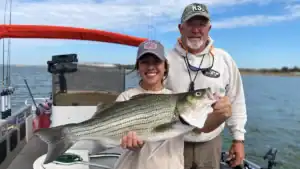
![[VIDEO] Swindle’s Fall Bass Bait Rotation for Shad Fisheries](https://www.wired2fish.com/wp-content/uploads/2024/11/fall-bait-rotation-300x169.webp)
